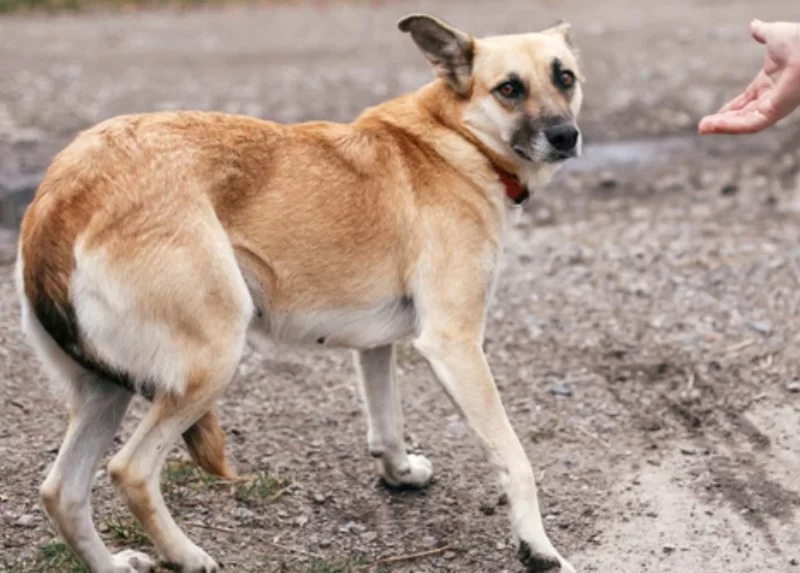Dog Tail Held Low and Tucked: Understanding Dog Body Language
- 1. What Does a Tucked Tail Mean in Dogs?
- 2. Why Do Dogs Tuck Their Tails Low?
- 3. Signs to Look For in Tucked Tail Dogs
- 4. How to Help a Dog Feeling Fearful or Stressed
- 5. Real-Life Case Study of a Tucked-Tail Dog
- 6. Why Choose Hidden Brook Veterinary for Your Dog's Care
1. What Does a Tucked Tail Mean in Dogs?
A dog’s tail is an important indicator of their emotions and overall well-being. When a dog holds its tail low and tucked between its legs, it is often a sign of fear, anxiety, or submission. This behavior is part of the dog's body language and is typically associated with feelings of insecurity or discomfort.
Understanding your dog's tail position can provide valuable insights into their emotional state. A tucked tail may indicate that the dog is nervous or frightened, but it can also be a response to unfamiliar situations or encounters with new people or animals.
2. Why Do Dogs Tuck Their Tails Low?
There are several reasons why a dog might tuck its tail low and between its legs. Some of the most common reasons include:
- Fear or Anxiety: Dogs often tuck their tails when they are frightened or anxious. This could be due to loud noises, unfamiliar environments, or meeting new people or animals.
- Submission: Dogs may also tuck their tails as a sign of submission to another dog or person, signaling that they are not a threat and are willing to avoid conflict.
- Pain or Discomfort: If a dog is experiencing physical pain or discomfort, they may tuck their tail as a protective instinct. This could happen if the dog is injured or unwell.
- Stress: High levels of stress, such as during a trip to the vet or a long car ride, can cause dogs to tuck their tails as a response to the stressful situation.
3. Signs to Look For in Tucked Tail Dogs
If you notice your dog has a tucked tail, it’s important to pay attention to other signs that might indicate the cause of their behavior. Here are some additional signs to look for:
- Body Posture: Dogs who are fearful or anxious may also crouch down, lower their body, or avoid direct eye contact.
- Vocalization: Dogs may whine, bark, or growl if they feel threatened or uncomfortable in a situation.
- Increased Heart Rate or Panting: If a dog is stressed or anxious, they may exhibit signs of a racing heart or excessive panting.
- Unusual Behavior: A dog that suddenly becomes withdrawn, refuses to eat, or hides may be showing signs of fear or distress.
It's important to take these signs seriously and address any underlying issues that could be causing your dog’s discomfort. Consulting with a veterinarian or behaviorist can help determine the best course of action.
4. How to Help a Dog Feeling Fearful or Stressed
If your dog’s tail is consistently tucked, they may be feeling fearful or stressed. Fortunately, there are several ways you can help your dog feel more comfortable and at ease:
- Provide a Safe Environment: Ensure your dog has a quiet and secure place where they can retreat when feeling stressed. A calm environment can help reduce anxiety.
- Positive Reinforcement: Use positive reinforcement techniques to help your dog build confidence. Reward them with treats and praise when they remain calm in stressful situations.
- Exercise and Play: Regular physical activity can help reduce anxiety and stress in dogs. Engaging your dog in playtime or walks can help them release pent-up energy and relax.
- Consult a Professional: If the behavior persists or is severe, it may be beneficial to consult with a professional dog trainer or veterinarian. They can provide specialized advice or therapy to help your dog manage their anxiety.
5. Real-Life Case Study of a Tucked-Tail Dog
Take the story of Max, a 3-year-old Labrador who had always been friendly and outgoing. However, after a traumatic experience during a thunderstorm, Max started exhibiting signs of fear and anxiety, including tucking his tail whenever loud noises occurred. His owners, Jane and Mike, were concerned and unsure how to help him.
After consulting with their veterinarian and a dog behaviorist, they learned that Max’s fear was linked to the thunderstorm experience. With a combination of positive reinforcement, desensitization training, and providing a safe space during storms, Max gradually became less fearful and more confident. Over time, his tail became less frequently tucked, and his behavior returned to normal.
Max’s story demonstrates that with the right support and patience, dogs can overcome fear-based behaviors and lead happier, more confident lives.
6. Why Choose Hidden Brook Veterinary for Your Dog's Care
If you’re concerned about your dog’s behavior or health, Hidden Brook Veterinary is here to help. Our experienced team can provide the guidance and care your dog needs, whether it’s addressing anxiety, fear, or any other behavioral issues. We offer personalized treatment plans and a compassionate approach to ensure your dog’s well-being.
Visit Hidden Brook Veterinary for expert advice and solutions tailored to your dog’s unique needs. Whether it's behavioral counseling or physical check-ups, we are here to help your dog feel comfortable and happy.












